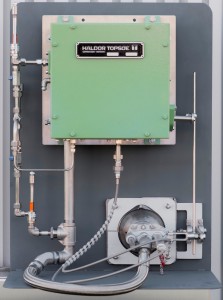Preventing furnace tube rupture failure during hydrotreater operations, whether resulting from sudden overheating, or some other operational mishap, is why technology such as infrared pyrometers for monitoring tube temperatures (e.g., in between every work shift) is a well known practice. Moreover, planning ahead for whatever can damage tubes very rapidly needs to be looked at considering the increase in hydrotreating capacity across the world. In the U.S. alone, the U.S. Energy Information Administration noted that as of January 1, refinery hydrotreating capacity for naphtha, gasoline, kerosene and diesel was 4.7 million bpd, 2.9 million bpd, 1.6 million bpd and 4.5 million bpd, respectively.
Haldor Topsoe’s TFM Image & Data Acquisition Unit.
This is why additional analytical systems have been added to these instrumentation assets. For example, Haldor Topsoe’s technology for monitoring furnaces, including tube temperatures, incorporates a system of multiple image acquisition and data acquisition units permanently installed on a firebox to monitor burner flame intensity, tube skin temperatures, and firebox component mechanical integrity on a continuous 24/7 basis to help locate hot spots. Known as Topsoe Furnace Manager (TFM), it captures images of the firebox at high frequency (an image every second for each image unit), and stores those images in an historian for future reference.
As discussed at a recent AFPM Q&A meeting, TFM provides alarms for temperatures outside of the designated operating envelope, alarms for burners with poor performance, continuous displays in the control room, as well as access remotely via computer networks. Immediate operational issues are revealed on the control room displays, and longer term planning is facilitated with images archived in the historian. This capability enhances overall operational effectiveness and operational excellence for the entire furnace support organization.
Haldor Topsoe’s Scott W. Sexton further added that “Comprehensive system reliability is equivalent to the plant’s utility supply (instrument air and power), enhanced by the inherent design encompassing multiple image and data acquisition units on the same firebox.” Sexton also emphasized that “Human interaction with the firebox is greatly reduced due to the remote accessibility of TFM data, and the continuous display of images in the control room. TFM data is captured and archived automatically so that data transfer hand-offs are minimized.” Further, Sexton adds “Furnace data analysis is no longer constrained by the ability to collect firebox data. TFM’s capability compared to the status quo is like calculus relative to algebra.” According to specifications available from Haldor Topsoe, TFM is built for industry with Class 1 Div 2 components, made for harsh industrial furnace applications.








Leave a Reply
You must be logged in to post a comment.